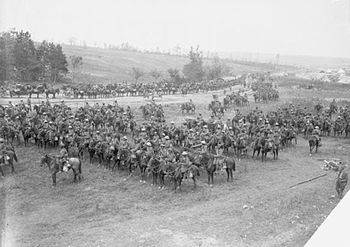- 9th Royal Deccan Horse
-
9th Royal Deccan Horse Active 1790 - 1947 Country British India Allegiance British Crown Branch British Indian Army Type Cavalry Size Regiment Part of Indian Cavalry Corps Nickname Deccan Horse Equipment Horse Engagements Second Afghan War-1879-1880
Burma War-1886-1888
China-1900Battle honours Central India
Battle of Givenchy
Battle of the Somme
Battle of Bazentin
Battle of Deville Wood
Battle of Flers Courcellete
Battle of Cambrai
France and Flanders 1914-18
Battle of Megiddo
Battle of Sharon
Capture of Damascus
Palestine 1918
Battle of Meiktilla
Rangoon Road
Capture of Meiktila
Defence of Meiktilla
Battle of Pyabwe
Burma 1942-45The 9th Royal Deccan Horse was a regular cavalry regiment of the British Indian Army , it was formed from the amalgamation of two regiments after World War I. They saw service from the Mutiny of 1857 up to and including World War II.
Contents
Formation
The 9th Royal Deccan Horse can trace its formation to 1790 when it was called Asif Sah's Irregular Cavalry. Two Regiments were raised for service under the Nizam of Hyderabad in Berar who was allied with the East India Company.[1]
During the following years the Regiment's title would change and they were known by the following titles over the years;
- 1st Regiment, Nizam’s Cavalry
- 2nd Regiment, Nizam's Cavalry
- 1st Cavalry, Hyderabad Contingent
- 2nd Cavalry, Hyderabad Contingent
- 1st Lancers, Hyderabad Contingent
- 2nd Lancers, Hyderabad Contingent.[1]
The Deccan Horse was frequently called for service during the 18th and 19th Centuries, winning a Victoria Cross in 1859 and was also awarded the battle honour, ‘Central India’..[1]
The Regiment was also in action during the Second Afghan War, the Burma War, and in China during the Boxer Rebellion. In 1903 during Kitcheners reform of the Indian Army the two Regiments were incorporated into the regular Indian Army with the titles XXth Deccan Horse and the 29th Lancers (Deccan Horse)..[1]
World War I
The 20th Deccan Horse was sent to France for service on the Western Front they were part of the 9th (Secunderbad) Cavalry Brigade of the 2nd Indian Cavalry Division.[2]
The 29th Lancers were also sent to France they formed part of the 8th (Lucknow) Cavalry Brigade of the 1st Indian Cavalry Division.[2]
Both Regiments would at times serve as Infantry in the trenches before being withdrawn for service in Palestine.[1]
Amalgamation
 9th Deccan Horse
9th Deccan Horse
The XXth Deccan Horse was awarded the titled Royal for their distinguished service during World War I, and in 1922 following the amalgamation of the two regiments, the Royal Deccan Horse (9th Horse) was formed.[1]
World War II
During the Second World War,the Regiment converted to tanks, and became part of the 255th Indian Tank Brigade[3] The regiment took part in the re-conquest of Burma.
Awards & Honours
Victoria Cross
Risaldar Badlu Singh, 14th Murray's Jat Lancers attached to the 29th Lancers , on September 23, 1918 at Kh. es Samariyeh, Jordan River, Palestine.
Citation: Risaldar Badlu Singh was attached to 29th Lancers when "on the morning of the 23rd September 1918, his squadron charged a strong enemy position on the west bank of the river Jordan, between the river and Kh. es Samariyeh village.
"On nearing the position, Risaldar Badlu Singh realised that the squadron was suffering casualties from a small hill on the left front occupied by machine guns and 200 infantry. Without the slightest hesitation he collected six other ranks and with the greatest dash and total disregard for danger, charged and captured the position, thereby saving very heavy casualties to the squadron. He was mortally wounded on the very top of the hill when capturing one of the machine guns single handed, but all the machine guns and infantry had surrendered to him before he died.
"His valour and initiative were of the highest order." [4]
Konsal Singh
- Description Medal card of Konsal Singh *[5]
- 20th Deccan Horse - Risaldar
- Date - 1914-1920
References
- ^ a b c d e f "geocities". Archived from the original on 2009-10-23. http://www.webcitation.org/5kjLt5oPc.
- ^ a b "cwgc.org". http://www.cwgc.org/ypres/content.asp?id=33&menu=subsub.
- ^ "wewerethere". http://www.wewerethere.defencedynamics.mod.uk/ww2/india_1.html.
- ^ London Gazette, 27 November 1918
- ^ name = "National Archive" Record Number WO 372/11 at http://www.nationalarchives.gov.uk
British Indian Army Cavalry Regiments 1903–1946Pre 1922 reforms 11th Prince of Wales's Own Lancers • 5th Cavalry 8th Cavalry 12th Cavalry • 31st Duke of Connaught's Own Lancers • 32nd Lancers • 36th Jacob's HorsePost 1922 reforms 1st Duke of York's Own Skinner's Horse • 2nd Lancers (Gardner's Horse) • 3rd Cavalry • 4th Duke of Cambridge's Own Hodson's Horse • 5th King Edward's Own Probyn's Horse • 6th Duke of Connaught's Own Lancers (Watson's Horse) • 7th Light Cavalry • 8th King George's Own Light Cavalry • 9th Royal Deccan Horse • 10th Queen Victoria's Own Corps Of Guides Cavalry (Frontier Force) • 11th Prince Albert Victor's Own Cavalry (Frontier Force) • 12th Cavalry (Frontier Force) • 13th Duke of Connaught's Own Lancers • 14th Prince of Wales's Own Scinde Horse • 15th Lancers • 16th Light Cavalry • 17th Queen Victoria's Own Poona Horse • 18th King Edward's Own Cavalry• 19th King George's Own Lancers • 20th Lancers • The Central India Horse (21st King George V's Own Horse)Categories:- British Indian Army regiments
- Honourable East India Company regiments
Wikimedia Foundation. 2010.

